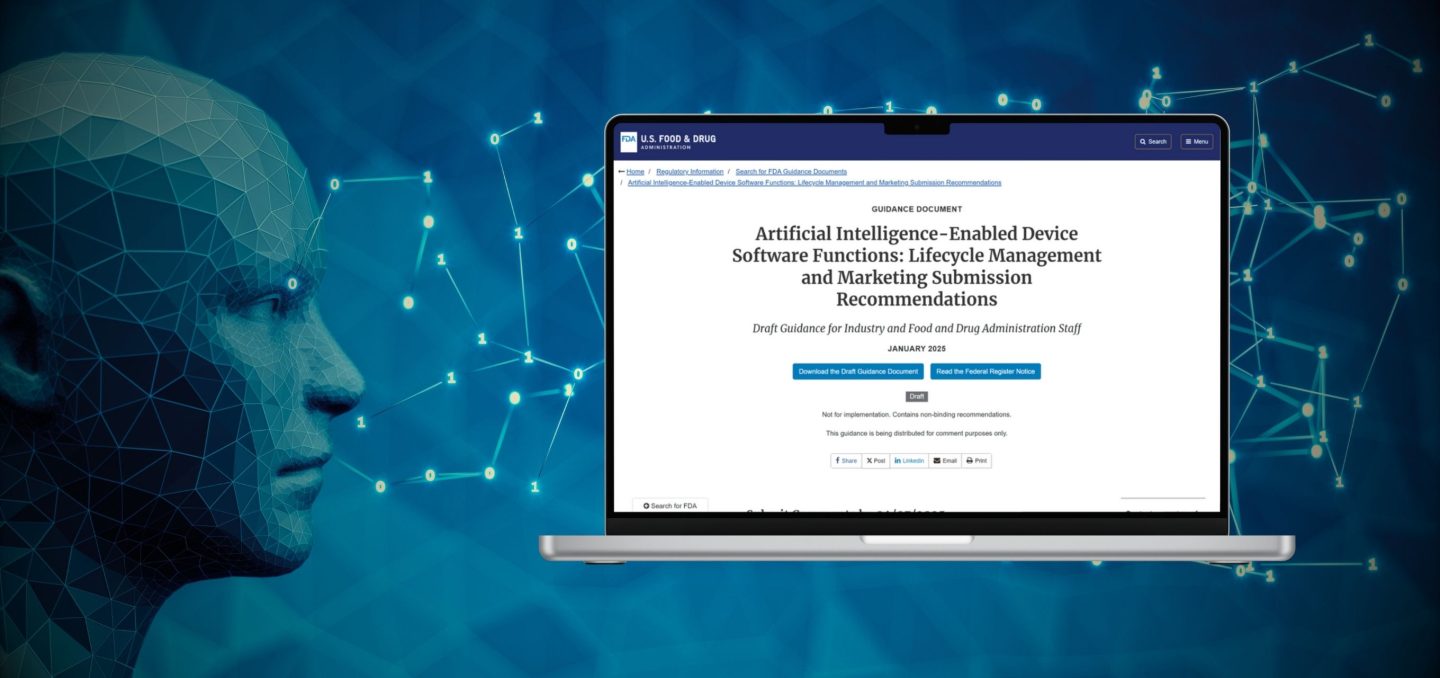The U.S. Food and Drug Administration (FDA) released a draft guidance titled “Artificial Intelligence-Enabled Device Software Functions: Lifecycle Management and Marketing Submission Recommendations.” This document outlines a Total Product Lifecycle (TPLC) approach to manage and market AI-enabled medical devices, addressing the unique challenges and risks of AI technologies.
Comprehensive Guidelines for AI-Enabled Devices
The FDA’s draft guidance ensures AI-enabled medical devices remain safe, effective, and reliable throughout their lifecycle. By integrating Good Machine Learning Practice (GMLP) principles and emphasizing transparency, the guidance gives manufacturers a clear regulatory roadmap. Key recommendations cover critical areas, including device description, risk assessment, data management, model validation, performance monitoring, and cybersecurity.
Key Recommendations:
1. Device Description
Manufacturers must detail device inputs, outputs, intended users, use environments, and workflows. These descriptions provide stakeholders with a clear understanding of device functionality and intended use.
2. User Interface and Labeling
The FDA requires clear communication of device functionality and performance. Manufacturers need to create user-friendly interfaces and comprehensive labeling for healthcare professionals and patients.
3. Risk Assessment
Manufacturers must develop comprehensive risk management plans to address potential hazards and user errors. These plans prioritize safety throughout the device lifecycle.
4. Data Management
Robust data collection, processing, and validation practices are essential. Manufacturers must ensure data diversity, quality, and quantity to mitigate bias and improve model accuracy.
5. Model Description and Development
The guidance highlights the importance of transparent AI model design. Manufacturers must document model architecture, training methods, performance metrics, and feature selection processes.
6. Validation
The FDA emphasizes rigorous validation studies, including human factors and usability testing, to confirm device performance in real-world scenarios.
7. Device Performance Monitoring
Postmarket monitoring plays a critical role in identifying and addressing performance changes. Manufacturers must implement proactive strategies to ensure ongoing reliability.
8. Cybersecurity
Manufacturers must adopt robust cybersecurity measures to protect against risks like data poisoning and model evasion, ensuring device integrity.
Transparency and Bias Mitigation
The new guidance prioritizes transparency and bias control. The FDA encourages manufacturers to use model cards, which are structured summaries that provide users with critical information about the AI model. Additionally, manufacturers must evaluate device performance across diverse demographic groups to ensure equitable outcomes.
Key Updates Compared to Previous Guidelines
The draft guidance introduces significant updates compared to previous FDA guidelines, addressing the complexities of AI-enabled technologies. Key advancements include:
- Total Product Lifecycle (TPLC) Approach
- Previous Guidelines: Offered general principles for lifecycle management.
- New Guidance: Focuses on the TPLC approach tailored for AI-enabled devices, covering design, development, deployment, and maintenance.
- Transparency and Bias
- Previous Guidelines: Provided limited focus on these areas.
- New Guidance: Includes detailed strategies for ensuring transparency and mitigating bias, such as subgroup analysis and demographic evaluation.
- Data Management
- Previous Guidelines: Offered general recommendations.
- New Guidance: Highlights data quality, diversity, and quantity as essential factors in AI model development.
- Model Description and Development
- Previous Guidelines: Required basic software descriptions.
- New Guidance: Demands comprehensive requirements covering model architecture, training methods, and quality control.
- Performance Validation
- Previous Guidelines: Included general validation requirements.
- New Guidance: Recommends specific evaluations for human-device interaction and subgroup performance.
- Cybersecurity
- Previous Guidelines: Provided general cybersecurity measures.
- New Guidance: Addresses AI-specific risks, such as data poisoning and performance drift, with tailored testing protocols.
- Public Submission Summary
- Previous Guidelines: Required basic public summaries.
- New Guidance: Emphasizes transparency with detailed public summaries and model cards.
- Device Performance Monitoring
- Previous Guidelines: Focused on general postmarket surveillance.
- New Guidance: Advocates for proactive monitoring and detailed analysis of real-world performance data.
- Usability Evaluation
- Previous Guidelines: Provided general usability recommendations.
- New Guidance: Focuses on user interaction and interpreting AI outputs.
A Framework for the Future of Digital Health
The FDA’s updated guidance demonstrates its commitment to fostering innovation while prioritizing patient safety. By addressing the unique challenges of AI-enabled devices, the agency establishes a robust framework for the future of digital health. This guidance helps manufacturers navigate regulatory pathways while promoting trustworthy, high-quality AI solutions to improve patient care.
As the FDA gathers feedback on this draft guidance, stakeholders across the healthcare ecosystem have an opportunity to shape the future of AI regulation. The focus on transparency, bias mitigation, and lifecycle management reflects the evolving needs of a digital health landscape increasingly driven by AI.



